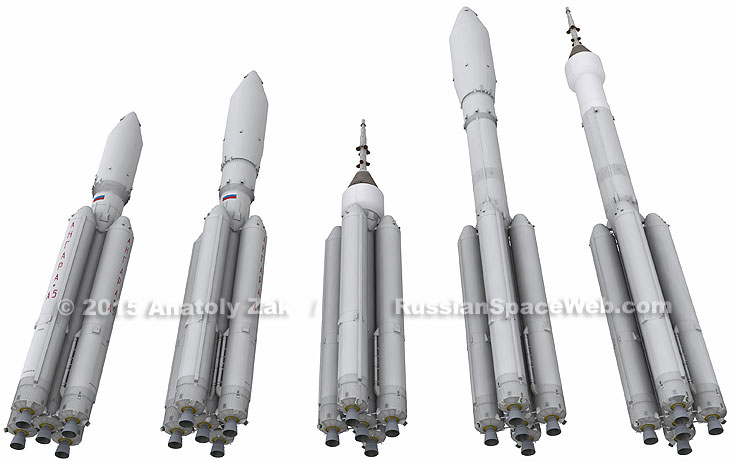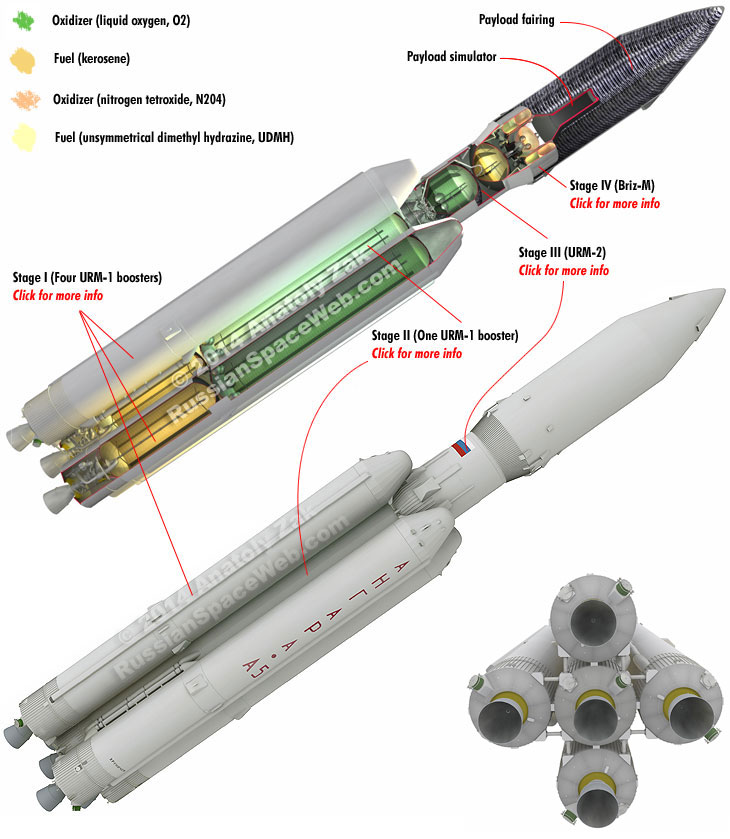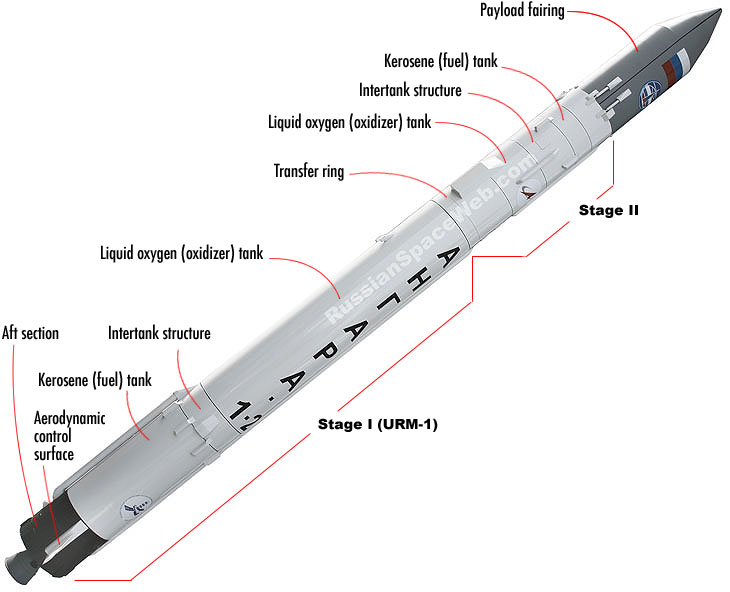The Russian Ministry of Defense will receive two heavy Angara launch vehicles in 2020, Roscosmos reported.
“This year, strict control is being exercised over the manufacture of the first Angara missiles, as well as their transfer to the customer, the Ministry of Defense of the Russian Federation. Prior to the completion of the reconstruction of Polet production association, the Khrunichev Center plans to produce annually two types of heavy-class launch vehicles – the Angara-A5 and one light-weight class – Angara-1.2,” the statement said.
It emphasized that the first launch vehicle will be delivered before the end of the first quarter of 2020, and the second – before the end of the year.
Roscosmos is confident that after achieving sufficient design capacity, the production volume will be eight heavy-class missiles and two light-class missiles per year.
It was previously reported that rocket launches will continue throughout 2020. Earlier, the head of Roscosmos Dmitry Rogozin reported that the launch of the Angara launch vehicle could take place closer to the New Year or after the New Year holidays.
It is assumed that the Angara should completely replace the Proton-M launch vehicles in 2024.
For the first time since the dissolution of the USSR, Russia will acquire a space launcher which could deliver more payload than the nation’s current workhorse Proton rocket.
The Angara A5
Angara-5 was designed as the main carrier of satellites for the Russian Ministry of Defense, for the Russian civilian space agency and for its commercial customers around the world. When launched from Plesetsk, Angara could deliver 24.5 tons of payload to the low Earth orbit, comparing to up to 22 tons carried by Proton to a similar altitude.
Unlike Proton, whose launches are only possible from Baikonur, thus holding Russia a hostage of its agreements with Kazakhstan, Angara would be based in Plesetsk, located few hundred kilometers north of Moscow. Unfortunately, due to the geographical location of Plesetsk, Angara-5 lost much of its payload advantage over the Proton. The Plesetsk-based Angara would be taxed particularly hard when carrying satellites to the equatorial (geostationary) orbit, which is its main destination.
Angara-A5 would use four standard URM-1 boosters as the first stage and a single URM-1 booster as its second stage. A prototype of the URM-1 made three flights as a part of the South-Korean KSLV rocket and also propelled the Angara-1.2PP rocket in July 2014.
The URM-2 booster would serve as the third stage. It also performed successfully during the flight of Angara-1.2PP.
The additional upper stages on Angara-5 would be used to send satellites from their initial parking orbits to the geostationary orbit or into deep space. Initially, the Briz-M upper stage using toxic storable propellants would be employed, only to be replaced with a more powerful KVTK space tug, burning liquid hydrogen.
Additionally, Roscosmos considered equipping Angara-5 with Block-DM upper stage for missions from Vostochny. When launched with Block-DM upper stage the rocket would be topped with a 14S75 payload fairing, while a version equipped with the KVTK upper stage would be using the 14S735 fairing.
As of July 2014, the first test launch of the Angara-5 rocket from Site 35 in Plesetsk was officially planned for December of the same year. The rocket lifted off on Dec. 23, 2014, and largely completed its flight program.
In mid-2014, the first deputy to Roskosmos head Aleksandr Ivanov told the Ekho Moskvy radio station that Angara-5 vehicles had already been ordered for launches of operational satellites scheduled in 2016 or 2017.
In an interview with the TASS news agency in August 2014, the head of GKNPTs Khrunichev Vladimir Nesterov said that during its second mission, Angara-5 would be carrying an operational payload, however the launch vehicle would officially remain in flight testing until 2020.
As of beginning of 2015, the second rocket was expected to leave the assembly line by November of that year.
In September 2014, officials at GKNPTs Khrunichev announced that by 2021 Angara-A5 would take over launches of all Russian government payloads, leaving Proton to deliver commercial missions. However, there appears to be a delay, as the current information is that the Angara launch vehicle family would replace the Proton by 2024.
The Angara 1.2
In addition to paving the way for the much larger Angara A5, Angara-1.2 was being positioned as the main light-weight delivery system for compact satellites of the Russian Ministry of Defense, the domestic civilian space agency Roscosmos and for international customers around the world.
The original version of the Angara-1.2 rocket was expected to have a liftoff mass of 171-tons and the capability to put 3.7 tons of cargo into the low Earth’s orbit from Plesetsk.
During the flight, the launch vehicle would be kept on course with the help of a gyroscopic system and an onboard computer derived from the Biser-6 flight control system both developed at the NPTs AP design center in Moscow. The Orbita telemetry system would process the flight data.
According to the original plans, the Angara-1.2 version would combine the standard URM-1 module with a diameter of 2.9 meters as its first stage and the URM-2 module as its second stage. The URM-2 module with a diameter of 3.6 meters derived from the already existing Block I stage, which had been developed for the Soyuz-2 rocket. As a result, the Angara-1.2’s top stage would have wider diameter than its lower rocket module.
In August 2014, the head of GKNPTs Khrunichev Vladimir Nesterov said that the light-weight version of the Angara rocket would be equipped with an “aggregate module,” which will be installed on top of the second stage and act as a space tug, completing the job of inserting satellites into their final orbits.
The new third stage was developed based on the company’s existing propulsion system and would fly for the first time in 2015 or 2016, after the first launch of the Angara-5 rocket, Nesterov said at the time.
In the first half of 2019, Roscosmos released footage of the checkout and test facility for the Angara 1.2, showing that progress was being made on the missile.
MORE ON THE TOPIC:









Luckily Space Supper Power U.S. will produce new engines (to replace Russian engines ) in 8 years time only!
That will be like 60+ years from (would be) moon landing They will finally produce engines powerful enough to get them on the moon….
“Huston we have problem” to understand all this !
Wernher Von Braun stated in order to get to the moon and return the astronauts you send “mankind would need to build a rocket as big as the Empire state building”.
The issue is in order to keep the crew safe an extremely thick
hull is required which cripples the fuel usage as the thrust required goes
through the roof and thus fuel consumption also goes through it also. Which means you need a bigger rocket which means you need more fuel for this bigger rocket!
NASA gave up on it and farmed it out to private companies after wasting 17 billion dollars in research and development programs to circumvent the protection problem.
That’s why the next set of tests are instrument only to venture beyond the belts to see if the Orion capsule is viable and what protection levels it can reach.
However this is the easy stuff its only taken 53 years and 160 billion dollars the real problem is how to slow the recovery module sufficiently in lunar orbit with no atmosphere to airbrake in. Or increase the fuel capacity of the surface landing module so when it lifts off it can reach the speed required to dock with the main module again for a return to earth. This though means a heavier capsule requiring more fuel a bigger rocket … blah blah blah yeah we’ve been here before!
Good, constructive, informative post.
My answer to your question is ORBITAL launch of the space ship from ISS space station is , only reasonable and safest option.
But that option was already proposed for Mars so why not for Moon?
Russians are already working on engines that use atomic pulses for motion for Mars and further away.
One option that they are exploring is to send 5 rocket ship into orbit filled with fuel and the 6th to bring supplies and the LEM that they choose.
The last ship will bring the crew to the ISS where they will stay until all the rockets are joined together to procedd to the moon.
The arguement against this option is it will make a complete bollocks of the Apollo story for the media and history
With Mars if they don’t go nuclear they will have to extract hydrogen fuel from Mars itself for the return
‘The arguement against this option is it will make a complete bollocks of the Apollo story for the media and history”
The APOLO”story” is always bollocks doesn’t matter what they do, there is no way around that problem…
If they don’t show those bollocks in “story” China most probably will .
Since new race to the moon is on!
Russia has really advanced with their atomic engine for space travel.
I don’t know for the others though.
to regular user of Southfront’s commentary fields: Z.P. diluting these threads is obviously mentally retarded and better left well alone, i.e. do not engage in any kind of exchanges with the idiot!
OK I never talk to him, honestly!
Not that it is important …but still…is Hitlers portrait tattoo on your left or on your right butt cheek?